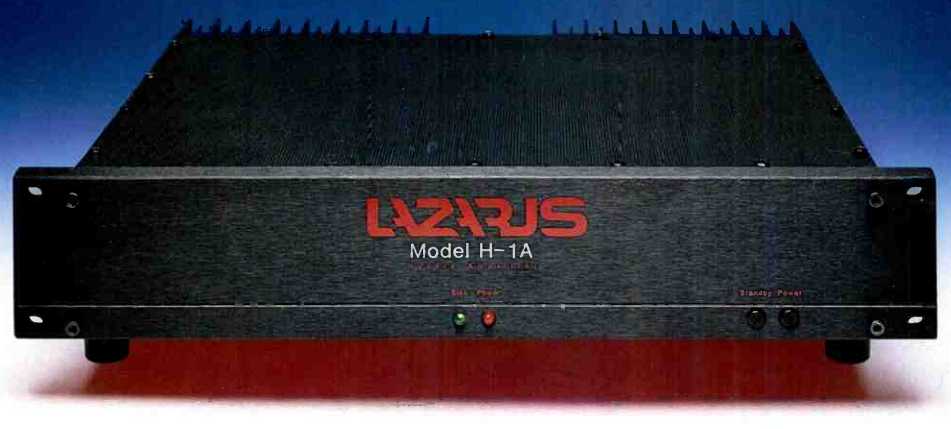
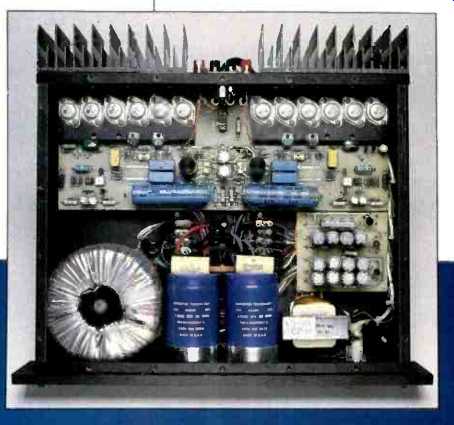
Manufacturer's Specifications:
Power Output: Stereo, 50 watts per channel into 8 ohms (Class A), 100 watts per channel into 4 ohms, 200 watts per channel into 2 ohms; mono, 200 watts into 8 ohms, 400 watts into 4 ohms, 400 watts into 1 ohm.
THD at Rated Output: 0.2%.
Full-Power Bandwidth: 5 Hz to 80 kHz.
Input Impedance: 47.5 kilohms.
Polarity: Stereo, inverting; mono, inverting or non-inverting at user's option.
Power Requirements: 117 V a.c., 250 watts (idle) to 1,500 watts peak.
Dimensions:
Front panel, 19 in. W x 3 1/2 in. H (48.3 cm x 8.9 cm); chassis, 17 in. W x 3 1/2 in. H x 15 in. D (43.2 cm x 8.9 cm x 38.1 cm).
Weight: 35 lbs. (15.9 kg).
Price: $1,920.
Company Address: 8130 Coldwater Canyon, North Hollywood, Cal. 91605.
Lazarus Electronics of North Hollywood, California, produces a number of all-tube and hybrid preamplifiers along with several hybrid power amplifiers. The Model H-1A is a two-channel hybrid power amplifier rated at 50 watts per channel into 8 ohms and is said to operate in Class A into this load. Rated power into 4 ohms is 100-watts per channel.
The unit can be bridged to produce 200 and 350 watts into 8- and 4-ohm loads, respectively. Additionally-and this is really unusual for a solid-state output stage-the amplifier's channels can be paralleled for operation into loads below 2 ohms! Physically, the unit is of reasonable size for its Class-A rated output power. Front-panel dimensions are 3 1/2 inches by rack width (19 inches). Depth is about 16 inches. Located on the front panel are two pushbuttons (one to switch between "Standby" and full operation, while the other is the main "Power" on/off switch) and two LEDs (a green one for "Bias" and a red one for "Power"). Most of the rear surface is taken up by heat sinks. An area between the heat sinks, some 3 1/2 inches square, holds the two Tiffany input phono jacks, a female XLR connector for balanced input in bridged mode, two sets of five-way binding posts for load connection, a power cord, and a line fuse. A hole just under the output binding posts allows the insertion of a nonmetallic tool to operate the stereo/mono switch. Space is tight but, with reasonable dexterity, large speaker wires can be connected. The hot terminals of the output are at the outside ends of the line of four five-way output binding posts. This makes the use of dual banana plugs impossible for speaker connection in the mono mode. This is just as well, as these plugs do degrade the sound, I believe.
Within the amplifier, the front half is taken up by power supply components; the rear part of the space holds the amplifier circuitry, mounted on a large p.c. board. There are actually a number of power supplies in the H-1A--one for the output stages and several for the tube front ends. The large toroidal transformer at left front and the filter capacitors in the middle front are for the output stages, while the smaller transformer and the p.c. board with lots of smaller capacitors are for the front-end circuitry. The six MOS-FET output devices per channel are mounted to 1/4-inch aluminum L brackets; the device leads are soldered to the p.c. board under these brackets. The other leg of each L bracket is coupled to the inside of the rear panel. Heat is transferred to the heat sinks through the rear panel metal.
Circuit Description
As hybrid power amplifiers go, the H-1A has about the simplest signal circuit I've seen (Fig. 1). The input stage is a cascode-connected 6DJ8 dual triode with a plate load resistor of 39 kilohms and an unbypassed cathode resistor of 475 ohms. In the stereo mode, each channel's cathode resistor is grounded. All of the circuit's voltage gain comes from this tube stage. Output from the tube front-end is coupled via two separate capacitors to the gates of a pair of complementary MOS-FET drivers which, in turn, drive the MOS-FET output devices. Both driver and output devices are connected as source followers. The output stage is composed of three N-channel and three P-channel MOS-FETs wired in parallel in two groups.
There is a bias-spreading network made up of two N-channel J-FETs wired in series. The lower device is wired as a constant-current source for the upper device, which is connected as a source follower. A variable resistor is connected between the lower device's drain and the upper device's source. These respective ends of the bias-adjust rheostat are connected to the P- and N-channel driver gates through 1-megohm resistors. An inverting servo compares the amplifier's output d.c. potential to ground (or 0 V d.c.) and applies the greatly amplified error to the gate of the upper J-FET device; this causes the amplifier's d.c. offset to approach 0 V d.c. The J-FETs are operated from the same zener-regulated supplies that power the servo op-amp. This servo and its connection with the J-FETs make up a neat design that I haven't seen before. No overall feedback loop is used in the Lazarus H-1A. Another clever aspect of this design is the way it switches between stereo and bridged-mono modes. As previously mentioned, the cathodes of the input stage's lower tubes are connected to ground through their respective cathode resistors. These resistors are tied together, and are grounded through one pole of the mono/stereo switch when it is in the stereo position. Also connected to the junction between the two cathode resistors is an additional resistor, on the order of 10 kilohms, whose other end is connected to a 90 V d.c. supply. When the H-1A is switched to bridged mono mode, the junction of the three resistors is ungrounded and voila! we have a differential amplifier formed from the two input stages. Whether either signal input is fed alone, or both are fed a balanced push-pull signal, the two hot terminals of the outputs will now be out of phase with each other and the mono load is to be connected between the hot output terminals.
In stereo mode, the H-1A's two channels both invert signal polarity. In mono mode, the signal will be inverted in whichever channel is fed a signal but will be uninverted at the output of the other channel. The amp will therefore provide push-pull outputs from the input differential amplifier regardless of which input receives the signal. The intended mode for mono operation, however, is for a balanced signal to be fed through the XLR jack. When this is done, the situation remains the same as when one phono jack is fed: The positive-going input still produces a negative-going signal at that channel's output. The way to connect one's speakers for overall noninverting operation in mono mode is to wire the speaker's positive terminal to the output of the channel that received the negative-going input signal.
The power supply for the H-1A, as already mentioned, uses two power transformers. The output-stage power transformer is a relatively large toroidal unit that seems appropriate to the unit's output power. Filter capacitance is quite high for an amp of this size and power output. Two 53,000-µF, 50-V units are used. Instead of the usual single full-wave bridge rectifier for both positive and negative d.c., the H-1A uses separate full-wave bridges with each of the two secondary windings to produce separate, full-wave rectified d.c. supplies-an interesting twist. These two d.c. supplies are connected in series via the usual common connection for the output stage. The designer feels that this helps to reduce unbalanced flux in the power transformer core for high power outputs at frequencies below 60 Hz.
The smaller transformer powers the tube front-end circuitry only. A time-delay/muting circuit is powered from the positive rail of the output-stage supply. Both the front-end and output-stage power supplies come up when the main "Power" switch is turned on. After the turn-on delay time has elapsed, pushing the "Standby" button (assuming it has not been pushed already) energizes a pair of two-pole relays.
These relays' contacts are normally closed, shorting both MOS-FET driver gates to ground, which ensures that turn-on surges from the front-end circuitry won't get through to the speaker output and keeps the output stage biased off.
Energizing the relays opens their contacts, biasing the output stage and enabling the unit to pass signal. If the "Standby" switch is pushed in at the same time that the main power switch is engaged, the amp will start playing immediately after the turn-on delay. For best sound, one should keep the "Power" switch on at all times and switch to "Standby" when the amp is not being used.
Returning to the front-end supply arrangement, we see that a full-wave bridge connected to the high-voltage winding of the small power transformer feeds two separate RC filter networks that provide the B+ for each tube input stage. Each of these B+ outputs feeds current through separate resistors to a zener regulator diode that supplies about +63 V to the upper front-end tubes' control grids. The output from another secondary winding goes through a full wave rectifier and RC filter to supply the -90 V for the frontend cathode resistor that is common when the unit is operated in the mono mode. Another pole of the stereo/mono switch ties the two separate front-end tube supplies together in the mono mode.
This interesting twist tends to cancel any signal voltage at these points, as the B+ ends of the plate load resistors are out of phase in the mono mode. The output of the last secondary winding goes through a full-wave rectifier and a capacitor input filter before being applied to the two frontend tube heaters, which are wired in series.
No protection circuitry seems in evidence in the H-1A other than the line fuse. How's that for confidence!
Measurements

Fig. 1--Simplified schematic, showing left channel and input stage of right
channel; see text
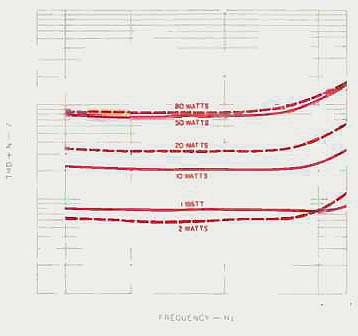
Fig. 2--THD + N as a function of frequency and power output for 8-ohm loads
(solid curves) and 4-ohm loads (dashed curves).
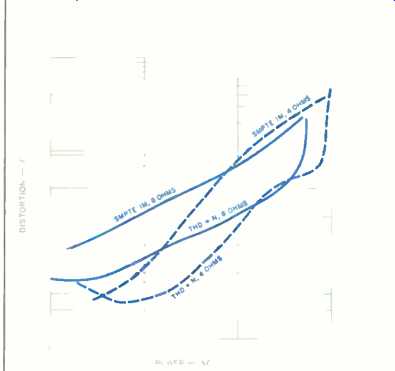
Fig. 3--SMPTE IM and THD + N vs. power for a 1-kHz signal into 8and 4-ohm
loads.
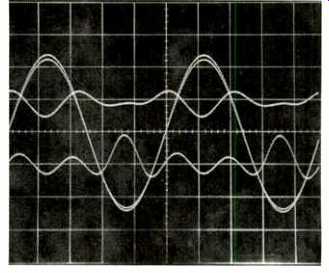
Fig. 4--Distortion residues and 1-kHz signal. For 10 watts into 8 ohms (upper
residue trace), THD measured 0.062%; for 20 watts into 4 ohms (lower residue
trace), it was 0.095%.
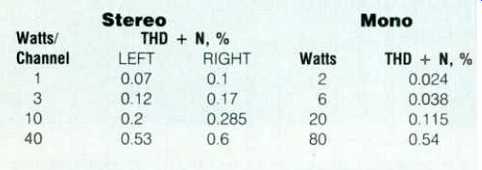
Table I--THD + N for 1-kHz signal, in stereo and bridged mono modes. Stereo
figures are with 8-ohm loads; mono figures are with 16 ohms, an equivalent
load (see text).

Table II--Output noise. The IHF S/N ratio was 83.5 dB for the left channel
and 94.0 dB for the right.
The standard FTC preconditioning tests at one-third power are interesting with a real Class-A amplifier, in that the output stage's current dissipation under those conditions is less than at idle. Incidentally, this unit's heat-sink temperatures get quite high at idle, when the power dissipation is on the order of 100 watts per channel. The unit had no trouble with one-third power into 8-ohm loads, and its heat-sinks were definitely cooler than they were at idle. When I tested the H-1 A at a third of the rated power (i.e., 33.33 watts) into 4-ohm loads, the heat-sinks got hotter than they did at idle, but otherwise the hour passed uneventfully.
Voltage gain for the H-1A measured 29.7 dB. The IHF input sensitivity was 93.5 mV. Total harmonic distortion plus noise is shown in Fig. 2 as a function of power, load, and frequency for 8- and 4-ohm loads. The two channels behaved similarly; the results shown are for the left channel. As can be seen in the figure, distortion rises only moderately at the high-frequency end of the audio range. (The reviewed unit carried no channel identification, so I applied my usual convention of identifying the channels as seen from the front of the unit.) Figure 3 shows THD + N for a 1-kHz signal, and SMPTE-IM distortion, as functions of power output for 8and 4-ohm loads. As shown, distortion at 100 watts per channel into 4-ohm loads is rather high. Visual onset of clipping into 4-ohm loads was about 88 watts per channel. Into 2-ohm loads, visual onset of clipping was at some 132 watts/channel, quite a distance from the claimed power output of 200 watts per channel.
Figure 4 shows typical harmonic distortion residue for a 1-kHz signal for 10 watts into 8 ohms and 20 watts into 4 ohms. The figure shows results for the left channel where, as can be seen, the dominant distortion is a combination of second and third harmonics. With 4-ohm loading, the right channel's THD residue was mostly odd-order.
To look at distortion characteristics in the mono mode, I constructed a low-distortion phase inverter that would allow me to drive both channels in push-pull with one channel direct from my Soundtech oscillator and the other driven from the phase inverter. Since the distortion in stereo mode at low power levels was mostly lower-order even harmonics, I expected to find less overall distortion at equivalent power and loadings in the mono mode, due to push-pull cancellation of even harmonics. (In mono mode, the equivalent to 8-ohm loading in stereo is 16 ohms between the hot output terminals. Also, the equivalent power is twice as high; this is because the voltage is doubled and the power is then equal to the square of this voltage divided by the doubled load impedance.) Table I shows some selected power and distortion figures for stereo and mono operation. As expected, distortion at low power levels was lower in bridged mono mode with the 16-ohm load because the even-order distortion products cancel out. At higher power levels, however, as the third harmonic starts to dominate, the distortion amounts are similar in both stereo and mono modes. There was little or no distortion with an 8-ohm load in mono, less than there was with 4-ohm loads in stereo because the distortion with these loads was mostly odd-order, and odd-order distortion doesn't cancel in push-pull topologies.
We have a winner here in the contest for flattest output impedance versus frequency. It can't get much flatter than this: Damping factor was 25 for the left channel and 24.2 for the right channel, from 20 Hz to 20 kHz. The output impedance is rather high, though, approaching that of many tube amplifiers. This means that the delivered frequency response to speakers whose impedance curves show wide variations will vary more than it would with amplifiers having lower output impedances.
Interchannel crosstalk as a function of frequency was also measured. The output level for the driven channel was 10 V rms, and the undriven input was terminated in 1 kilohm.
Results were within a dB or so of being symmetrical, and were around-80 dB between 20 and 300 Hz, increasing to 76 dB at 1 kHz,-66 dB at 5 kHz, and to about-55 dB at 20 kHz. These numbers are for the slightly worse, right-to left direction, with the driven channel loaded by 8 ohms. As with many amplifiers I have measured, this one had somewhat less crosstalk when the driven channel was unloaded, on the order of 6 to 10 dB, which means that the crosstalk level is somewhat load-dependent. Output noise for different bandwidths and IHF signal-to-noise ratios are given in Table II.

Fig. 5--Square-wave response. Top trace is 10 kHz, with 8-ohm load; middle
trace is same signal, with 2-µF capacitance across the 8-ohm load; bottom
trace is 40 Hz into 8 ohms. (Scales: Vertical, 5 V/div.; horizontal, 20 µS/div.
for 10 kHz, 5 mS/div. for 40 Hz.)
Dynamic headroom in stereo mode with 8-ohm loading worked out to about 0.22 dB. With 4-ohm loading, the attainable power was less than the rated 100 watts (with no distortion spec) and the headroom number comes out at -0.4 dB. Clipping headroom was +0.17 dB with 8-ohm loads, but was -0.56 dB with 4-ohm loading. With only one channel driven, output was about ±20 amperes into a 1-ohm load.
Frequency responses, for 1-watt output with 8-ohm loading and for 2 watts into 4 ohms, were flat down to my low frequency measuring limit of 10 Hz, and were about 2 to 3 dB down at 100 kHz. The two channels had slightly different roll-off curves, with the right channel being down more than the left. The difference between 8and 4-ohm loading was slight. Rise- and fall-times at ±5 V into 8 ohms were 2.8 and 3.2 for the left and right channels respectively. 'Scope photos of square-wave performance are displayed in Fig. 5 where the top trace is for 10 kHz with 8-ohm loading, the middle trace is for 8 ohms with an added 2µF of capacitance, and the bottom trace is for 40 Hz into 8 ohms. The unit has a small amount of ringing with the added 2µF; the small amount of tilt in the 40-Hz waveform indicates extended response below the audio band.
The regulation of bias, or quiescent current, with temperature is overstable, meaning that as the unit heats up the current decreases. This is most likely due to the negative temperature characteristic that the Hitachi MOS-FETs exhibit at the currents used. The a.c. line draw was about 2.5 amperes when the amp was cold and about 2.0 amperes when warmed up. How perfectly Class A is the amplifier into 8-ohm loads ? I couldn't easily measure output-stage current, as there were no source feedback resistors in the output stage, and I don't have a current probe. Judging by a.c. line draw as a function of output power into 8 ohms, however, the H-1A is pretty close to being Class A all the way up to clipping: The a.c. line draw rose only slightly, from 2.0 amperes at idle to about 2.5 amperes at 50 watts per channel.
Summarizing the measured behavior of the H-1A, on the plus side of the ledger are its low-order harmonic distortion, flat output impedance with frequency, and its lack of slewing distortion. Or the not-so-hot side are the relatively high distortion at high power levels and the fact that the amp does not really make its power spec into low-impedance loads with sufficiently low distortion.
Use and Listening Tests
Equipment used to evaluate the H-1A power amplifier included, as signal sources, an Oracle turntable fitted with a Well Tempered arm and Spectral Audio MCR Select cartridge, a Magnavox CDB-560 CD player feeding a Wadia 2000 decoding computer, a Nakamichi 250 cassette deck, and a Technics 1500 open-reel recorder. Preamps used were my Cook-King reference unit (which combines a phono preamp with a passive selector switch and stepped attenuator) and an Illusion No. 8 tube preamp. Other power amps used were my reference EAR 519 tube units and VTL Compact 100s and deLuxe 120s. Speakers used were Siefert Research Magnum IIIs.
(An aside on the Wadia 2000. I have been using one of these wonderful devices for 2 to 3 months courtesy of a loan by Wadia to Audio for evaluation purposes. I have to agree with all the accolades it has received in various reviews. My own experience is that it drastically opens up the space and depth in CD reproduction and generally reduces irritation levels in the high-frequency region. Also, the bass quality is killer.) Before receiving this updated sample for review, I had an earlier H-1A which, judging by the newer sample, may not have been representative of Lazarus's actual production. I did not like the earlier unit's sound, which was harsh, closed in, and generally irritating.
Ah, but the unit I reviewed! Much to my surprise and delight, I now have another amplifier in residence that I enjoy listening through. Spectrally, the sound of this amp seems to be tilted down over the audio range, with the bass elevated and the treble reduced. The resultant sound is highly listenable and non-irritating. Bass extension and power are downright impressive. Space, air, and dimensions are quite good. (However, when I go back to my reference EAR 519s, the overall sound is more open and believable.) As with other Class-A designs, the H-1 A sounds louder than its rated power might indicate and plays plenty loud for me.
Operationally, the H-1A worked flawlessly. The delay/ mute circuitry worked with nary a click or pop. I left the main power switch on all the time I was using the amp and flipped the "Standby" switch to listen to it. When operated this way, optimum sound occurs in about 15 minutes. From a cold turn-on, optimum sound takes much longer.
Summing up, I think the H-1A is a very good sounding power amplifier and I certainly recommend giving it an audition. I certainly enjoyed its stay at my house.
-Bascom H. King
(Source: Audio magazine, Sept. 1990)
Also see:
Heathkit AA-1800 Stereo Power Amp (Sept. 1982)
= = = =